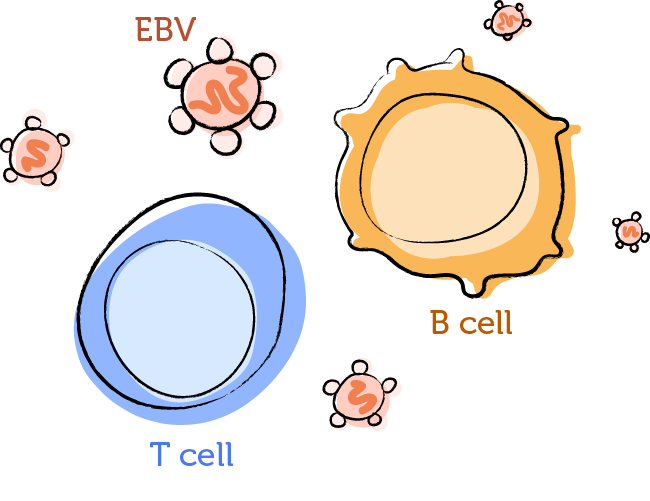
What is PTLD?
PTLD stands for Post‑Transplant Lymphoproliferative Disease or Disorder.
'Lympho' refers to lymphocytes, a type of white blood cell.
'Proliferative' means growing or multiplying quickly.

PTLD stands for Post‑Transplant Lymphoproliferative Disease or Disorder.
'Lympho' refers to lymphocytes, a type of white blood cell.
'Proliferative' means growing or multiplying quickly.

PTLD is when your
lymphocytes
grow out of control after a transplant. It can develop in anyone taking immunosuppressants after a transplant.
PTLD is a
group of diseases.
It includes certain kinds of growths and lymphomas. PTLD can become life-threatening. It needs to be brought up to the transplant team so they can diagnose and treat it quickly.
PTLD is often linked to the
Epstein‑Barr virus (EBV).
If there is a link, it's called EBV‑positive PTLD. If there is no link, it's called EBV‑negative PTLD.
Anyone taking immunosuppressants after a transplant is at risk for PTLD:

Your transplant team monitors the health of your transplant. They also look for signs of post‑transplant complications, including PTLD.
The symptoms of PTLD are broad. They can overlap with symptoms of other conditions. Symptoms can be different in different people, and may include:
These symptoms may not mean you have PTLD, but they should be looked at by your transplant team.
If you notice
anything new or a general change in how you're feeling,
tell your transplant team or healthcare provider right away. Don't wait until your next appointment.
If you see a healthcare provider other than your transplant team, including in urgent care or the emergency room, tell them about your transplant and immunosuppressants. They may need to reach your transplant team.
After a transplant, the immune system needs to be weakened with immunosuppressants. This is an important part of preventing rejection or graft-versus-host disease (GvHD) and keeping the transplant healthy. When the immune system is weak, an EBV infection can become active. This can increase the risk of EBV‑positive PTLD. Scientists are still studying what causes EBV‑negative PTLD.
Read more below to see the details.
Immunosuppressants are an important part of your transplant health.
Do not stop taking them or change how you are taking them, unless your transplant doctor tells you to.
If you've had a transplant, you might want to know: What causes EBV-positive PTLD?
We can find clues right in the name of this disease, which stands for Epstein-Barr Virus-positive Post-Transplant Lymphoproliferative Disease or Disorder.
EBV is a virus that nearly everyone picks up in their lifetime.
Post-transplant is another way of saying after a transplant.
For the next clue, let's look closely at a drop of blood. Lympho comes from lymphocytes. These are cells in your blood, and include T cells and B cells. As part of your immune system, these cells help defend your body against germs and diseases.
Proliferative means growing or multiplying quickly.
Now, let's put these pieces together.
EBV can get inside the B cells of your body. B cells with EBV can grow so there are more and more of them.
Usually, T cells get rid of most of the B cells that have EBV. This is why most people with EBV don't get sick. So why can things change after a transplant?
After a transplant, you take medications called immunosuppressants.
These medications slow your T cells down. This helps keep your transplant healthy. But the slowed-down T cells may have a harder time getting rid of B cells with EBV, which can continue to grow or multiply. This can lead to EBV‑positive PTLD.
It's important to take your immunosuppressants, and to tell your family about how you're feeling. Together, you can talk to your doctor about any questions you have.
LIM-foh-sites
Lymphocytes are white blood cells. They are a part of your immune system. There are three main types:
Each type of lymphocyte protects your body from infections and diseases in its own way.
ep-stine-BAR VY-rus
EBV is one of the most common viruses that people can get. It is also known as human herpesvirus 4.
Most adults will have had an EBV infection and carry EBV without any symptoms. EBV may cause symptoms in people with a weakened immune system.
TRANZ-plant ree-JEK-shun
Transplant rejection is when your immune system attacks the donor tissues or cells. Immunosuppressants must be taken to prevent this.
GRAFT ver-sus HOST dih-zeez
Graft-versus-host disease is when the donor's immune cells from the transplant attack your body. Immunosuppressants must be taken to prevent this.
T-sel ruh-moo-vl
T-cell removal is the process of removing or reducing T cells from donor grafts in blood stem cell transplant. It is done to lower the chances of GvHD.
T-cell removal is also called T-cell depletion.
ep-stine-BAR VY-rus AK-tiv stayt
When EBV is in its active state, it can make many copies of itself and spread.
The active state is also called the lytic phase.
ep-stine-BAR VY-rus DOR-ment stayt
When EBV is in its dormant state, it does not make copies of itself and spread. It hides inside B cells and can cause them to multiply abnormally. T cells keep these B cells under control.
EBV in its dormant state is harder for the immune system to detect and get rid of. This is how EBV can stay in the body without causing symptoms.
EBV in its dormant state may become active again if the immune system is weakened.
The dormant state is also called the latent phase.
wite blud sels
White blood cells are a part of your immune system.
There are different types of white blood cells:
Each type of white blood cell protects your body from infections and diseases in its own way.